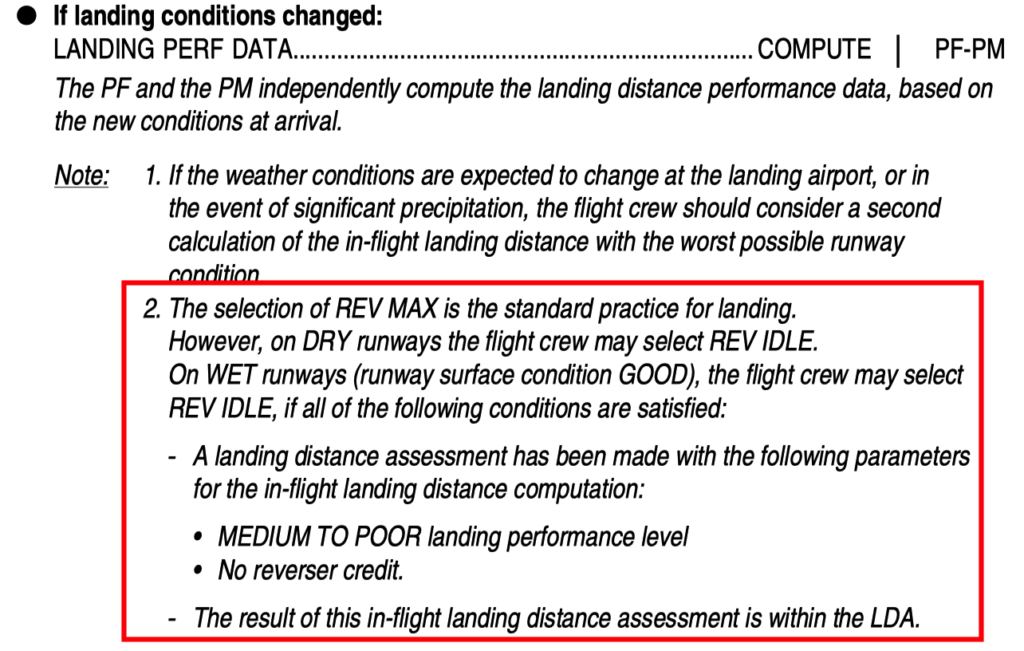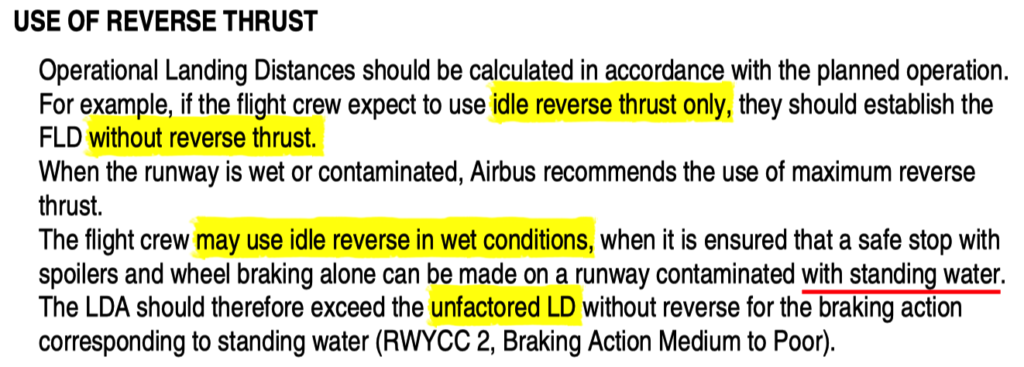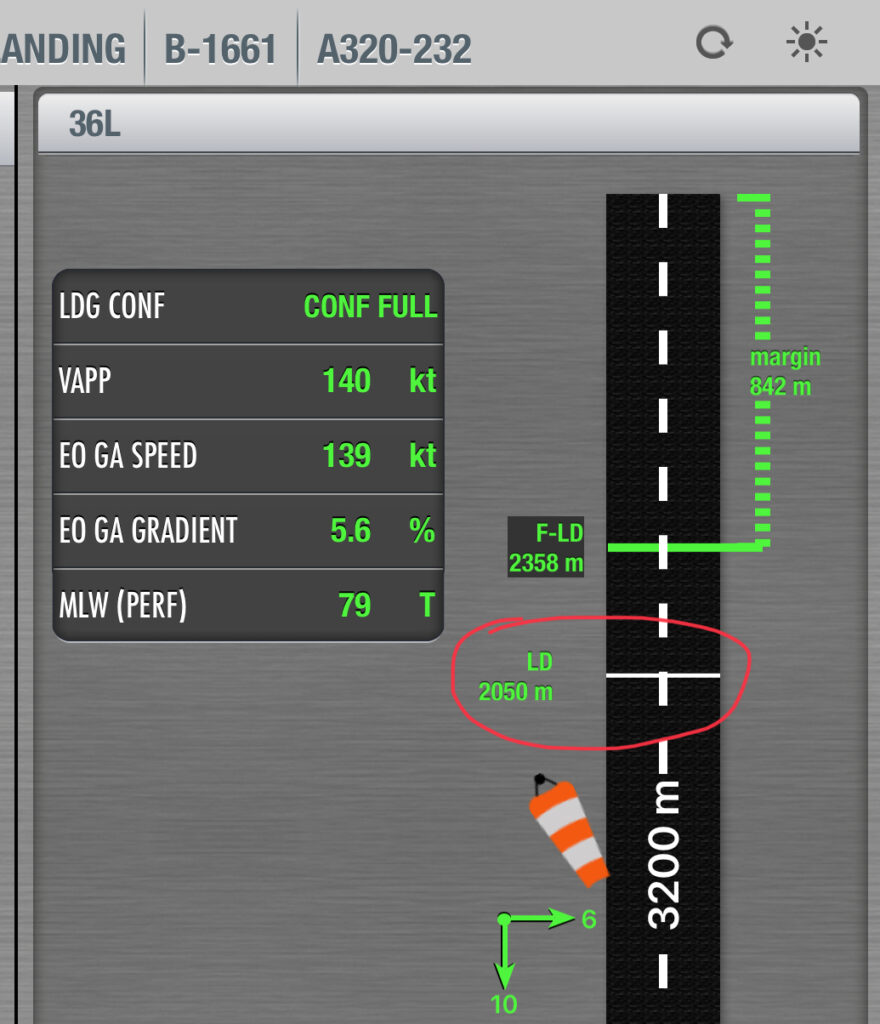在 SOP 的进近准备中,关于着陆性能计算有一些注释,其中一条不好理解:
在湿跑道上,如果机组决定使用小反推,则需要使用以下条件来计算:
- 道面条件 MEDIUM TO POOR
- 不选择反推
如果计算出来的距离小于 LDA,则可以使用小反推。
按照 FCTM PR-NP-SOP-160 SOP - DESCENT PREPARATION 中的描述,如果要使用小反推,应该选择 "NO REV",这个是可以理解的:
但问题是:
本身"道面条件 GOOD + NO REV" 就已经比"道面条件 GOOD + REV IDLE” 严格了,为什么还要再选择“道面条件 MEDIUM TO POOR”呢?
空客回复了很多,核心观点就是,机场部门是很难实时观察道面积水是否超过 3mm 的,也就是"WET"和"STANDING WATER" 的临界值,同时也是道面条件"GOOD"和"MEDIUM TO POOR"的临界值。对于积水来说,小于等于 3mm RWYCC 就是 5,大于 3mm 就是 2,中间的 4 和 3 是针对雪的,和积水无关。多次事件报告也表明,在报告"WET"的道面上,机组并没有感受到正确的刹车能力。
所以,为了安全起见,如果要在湿跑道上使用小反推,除了对“小反推”进行保守计算为“无反推”,还要对“湿跑道”进行保守计算为"STANDING WATER",所以合在一起就是按照"道面条件 MEDIUM TO POOR + NO REV"来计算。
需要注意的是,在上述 FCTM PR-NP-SOP-160 SOP - DESCENT PREPARATION 文中所说的,是 LDA 要大于 unfactored LD,也就是不加上 15% 的着陆距离,而不是 F-LD。
可能会出现提示信息:
TechRequest 原文
Q:
In PRO-NOR-SOP-160 A LANDING PERF DATA COMPUTE, the description of WET runways computation seems not inaccurate.
For WET runway with REV IDLE, "MEDIUM TO POOR landing performance level" and "No reverser credit" should not be chose at the same time. Because only "GOOD with No reverser" is already more strict than "GOOD with REV IDLE". No need to further downgrade to "MEDIUM TO POOR".
I think it should be "MEDIUM TO POOR with REV MAX" OR "GOOD with NO REVERSER". And verified in FLY SMART, they stop margin of those two are very close.
A:
Please find below the recommendation given in A350 FCOM PRO-NOR-SOP-160 "Descent Preparation":
"Note:
2.The selection of REV MAX is the standard practice for landing.
However, on DRY runways the flight crew may select REV IDLE.
On WET runways (runway surface condition GOOD), the flight crew may select REV IDLE, if all of the following conditions are satisfied:
- A landing distance assessment has been made with the following parameters for the in-flight landing distance computation:
- MEDIUM TO POOR landing performance level
- No reverser credit.
- The result of this in-flight landing distance assessment is within the LDA"
The first point that Airbus would like to highlight is that Airbus recommendation is to use REV MAX for landing.
For In-Flight Landing computation, the performance on WET runway (up to 3 mm of water) should be computed with Runway Condition Code 5 (GOOD) when using REV MAX.
However, following operators' requests, Airbus has performed a study to give the possibility to use REV IDLE instead of REV MAX on WET runway.
In this case, the flight crew must follow the safety precautions as described in the note reminded above: the flight crew must check that the in-flight landing distance computed with Runway Condition Code 2 (MEDIUM TO POOR) and no reverser credit is within the LDA (Landing Distance Available).
Such safety precautions have been defined based on Airbus experience. The aim is to protect against a degraded runway condition, as it is very difficult for airports to observe in real time the potential accumulation of water on the runway above a depth of 3mm, where the runway condition moves from WET to Standing Water (i.e. from GOOD to MEDIUM TO POOR).
In several in-service events, the flight crew did not have a correct perception of the braking capability on a runway reported to be WET.
The use of REV MAX is a major mitigation of such unexpected degraded conditions.
When landing with REV IDLE is planned, the exposure to a runway excursion is increased. Thus, Airbus has developed this guidance to ensure a good safe margin for such operations.
Therefore, Airbus would like to confirm that, even if WET runway is Runway Condition Code 5 (GOOD), the in-flight landing performance must be computed without the reverser credit and with MEDIUM TO POOR landing performance level in case of landing with REV IDLE on a WET runway.
If the in-flight landing distance calculated is higher than the LDA, then landing with REV MAX must be performed.
Please note that additional information is given in FCTM PR-NP-SOP-160 "Descent Preparation" / "Landing Performance" / "USE OF REVERSE THRUST" :
"The flight crew may use idle reverse in wet conditions, when it is ensured that a safe stop with spoilers and wheel braking alone can be made on a runway contaminated with standing water. The LDA should therefore exceed the unfactored LD without reverse for the braking action corresponding to standing water (RWYCC 2, Braking Action Medium to Poor)."





